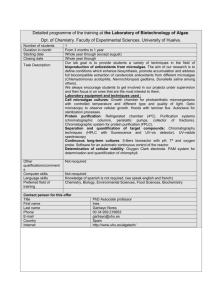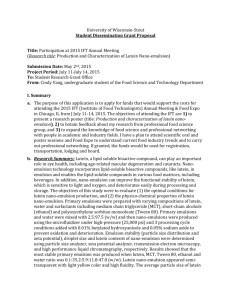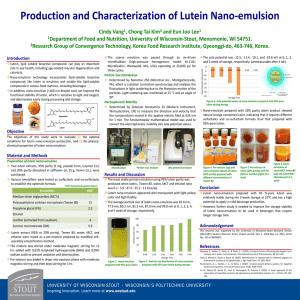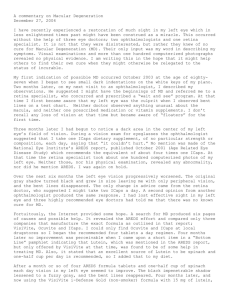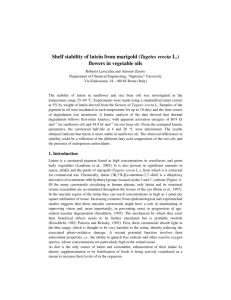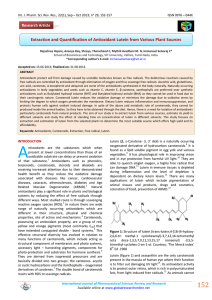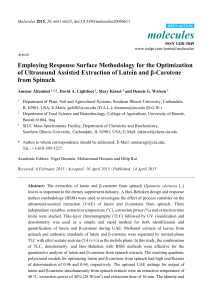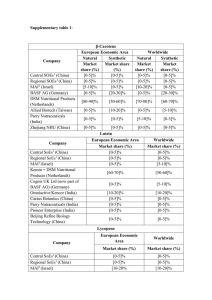REPORT HIGHLIGHTS
advertisement
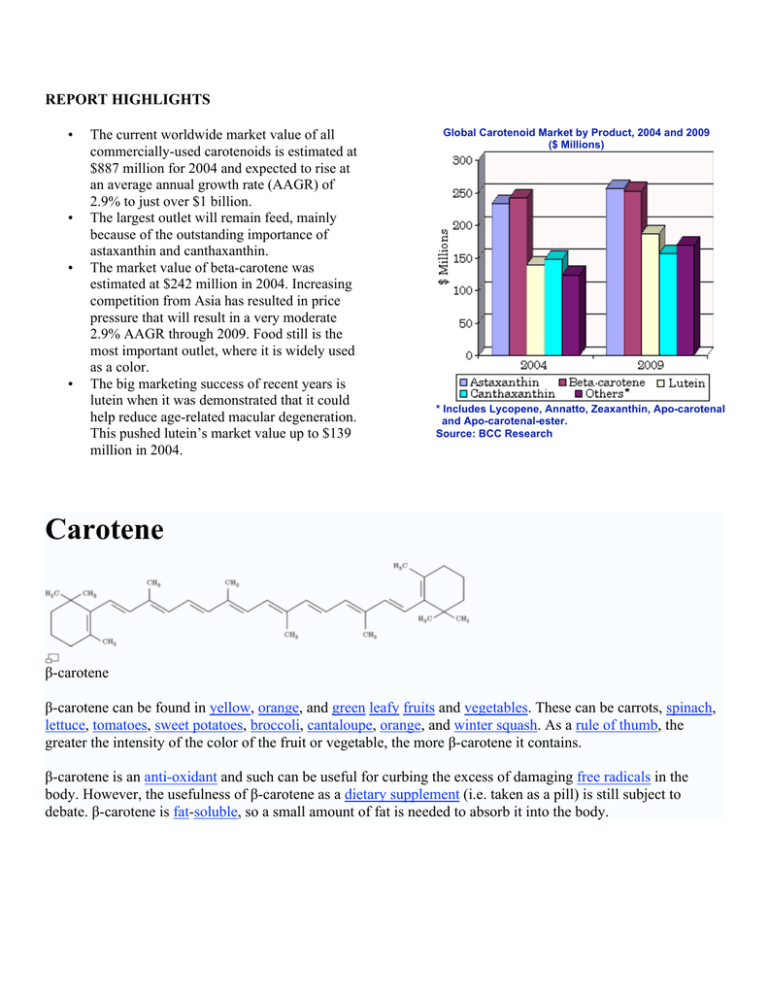
REPORT HIGHLIGHTS • • • • The current worldwide market value of all commercially-used carotenoids is estimated at $887 million for 2004 and expected to rise at an average annual growth rate (AAGR) of 2.9% to just over $1 billion. The largest outlet will remain feed, mainly because of the outstanding importance of astaxanthin and canthaxanthin. The market value of beta-carotene was estimated at $242 million in 2004. Increasing competition from Asia has resulted in price pressure that will result in a very moderate 2.9% AAGR through 2009. Food still is the most important outlet, where it is widely used as a color. The big marketing success of recent years is lutein when it was demonstrated that it could help reduce age-related macular degeneration. This pushed lutein’s market value up to $139 million in 2004. Global Carotenoid Market by Product, 2004 and 2009 ($ Millions) * Includes Lycopene, Annatto, Zeaxanthin, Apo-carotenal and Apo-carotenal-ester. Source: BCC Research Carotene β-carotene β-carotene can be found in yellow, orange, and green leafy fruits and vegetables. These can be carrots, spinach, lettuce, tomatoes, sweet potatoes, broccoli, cantaloupe, orange, and winter squash. As a rule of thumb, the greater the intensity of the color of the fruit or vegetable, the more β-carotene it contains. β-carotene is an anti-oxidant and such can be useful for curbing the excess of damaging free radicals in the body. However, the usefulness of β-carotene as a dietary supplement (i.e. taken as a pill) is still subject to debate. β-carotene is fat-soluble, so a small amount of fat is needed to absorb it into the body. Production Most of the world's synthetic supply comes from a manufacturing complex located in Freeport, Texas and owned by DSM. This site uses Blakeslea trispora in a fermentation process for the production of beta-carotene. Lutein Lutein (LOO-teen) is one of over 600 known naturally occurring carotenoids. Found in green leafy vegetables such as spinach and kale, lutein is employed by organisms as an antioxidant and for blue light absorption. Lutein is covalently bound to one or more fatty acids present in some fruits and flowers, notably marigolds (Tagetes). As a pigment This xanthophyll, like its sister compound zeaxanthin, has primarily been used as a natural colorant due to its orange-red color. Lutein absorbs blue light and therefore appears yellow at low concentrations and orange-red at high concentrations. Lutein was traditionally used in chicken feed to provide the yellow color of broiler chicken skin. Polled consumers viewed yellow chicken skin more favorably than white chicken skin. Such lutein fortification also results in a darker yellow egg yolk. Today the coloring of the egg yolk has become the primary reason for feed fortification. Lutein is not used as a colorant in other foods due to its limited stability, especially in the presence of other dyes. Health benefits for eyes Lutein was found to be present in a concentrated area of the macula, a small area of the retina responsible for central vision. The hypothesis for the natural concentration is that lutein helps protect from oxidative stress and high-energy light. Various research studies have shown that a direct relationship exists between lutein intake and pigmentation in the eye. Several studies also show that an increase in macula pigmentation decreases the risk for eye diseases such as Age-related Macular Degeneration (AMD). Lutein is a natural part of human diet when fruits and vegetables are consumed. For individuals lacking sufficient lutein intake,lutein-fortified foods are available, or in the case of elderly people with a poorly absorbing digestive system, fortification via a sublingual spray ensures maximum benefit to the eyes. As recently as 1996, lutein has been incorporated into dietary supplements. While no recommended daily allowance currently exists for lutein as for other nutrients, positive effects have been seen at levels of 6 mg/day. The only definitive side effect of excess lutein consumption is the same observed for β-carotene overdose, namely bronzing of the skin (carotenodermia). The normal levels of Lutein found in a daily vitamin tablet can be as low as 0.25mg. The functional difference between the benefits of lutein and lutein esters is not entirely known. It is suggested that the bioavailability is lower for lutein esters, but much debate continues. Commercial value The commerciality of lutein has recently exploded with an estimated market value of $139 million in 2004, compared to $64 million in 1999. It is one of the fastest growing areas of the $887 million carotenoid market. There are several lutein ester suppliers, but few pure lutein suppliers due primarily to patent protections on obtaining purified lutein from natural products, namely marigolds. Nevertheless, the market value of lutein is anticipated to grow at an average annual growth rate (AARP) of over 6%. Astaxanthin Astaxanthin (pronounced as-tuh-zan'-thin) is a carotenoid. It belongs to a larger class of phytochemicals known as terpenes. It is classified as a xanthophyll, which means 'yellow leaves'. Like many carotenoids, it is a colorful, fat/oil-soluble pigment. Astaxanthin can be found in microalgae, yeast, salmon, trout, krill, shrimp, crayfish, crustaceans and the feathers of some birds. [1][2] Professor Basil Weedon was the first to map the structures of astaxanthin. Astaxanthin, unlike some carotenoids, does not convert to Vitamin A (Retinol) in the human body. Too much Vitamin A is toxic for a human, but astaxanthin is not. However, it is a powerful antioxidant. It is 10 times more capable than other carotenoids.[3] While astaxanthin is a natural nutritional component, it can be found as a food supplement. The supplement is intended for human, animal and aquaculture consumption. The commercial production of astaxanthin comes from both natural and synthetic sources. The FDA approved astaxanthin - as a food coloring (or color additive) for specific uses in animal and fish foods. The European Union considers it food dye. Canthaxanthin Canthaxanthin is a food additive used for farmed salmon raised in environments where astaxanthin sources are not available. Canthaxanthin gives salmon a pink color similar to pink/red species of wild salmon, while at the same time acting as an antibiotic. Canthaxanthin is a permitted color additive in foods and animal feeds in many countries including the Mainland, EU, US and Canada. In the United Kingdom, Canthaxanthin is allowed by law to be added to poultry feed, some sausages mainly exported to france, and trout and salmon feed. Health concerns have raised the issue of safety concerning the usage of canthaxanthin in commercially sold salmon. As a result, in the United States, food packaging must indicate if artificial coloring (including, but not limted to canthaxanthin) is added to the fish. In addition, the European Union has set limits on how much canthaxanthin commercially sold fish may contain. The analysis of canthaxanthin content in salmon is a scientifically-accepted method to determine the origin of salmons. Canthaxanthin capsules were also used extensively in the 1990s as a "tanning pill" since the substance would accumulate in the fatty tissue immediately underneath the skin, resulting in a reasonable facsimile of a natural sun tan. Such usage declined — but has not disappeared entirely — after the Food and Drug Administration in the United States withdrew approval of its use for this purpose in 1999, citing cases of color blindness and related visual difficulties, resulting from the fact that the substance can become lodged in the retina; vision does return to normal after use is discontinued in most cases, however.
